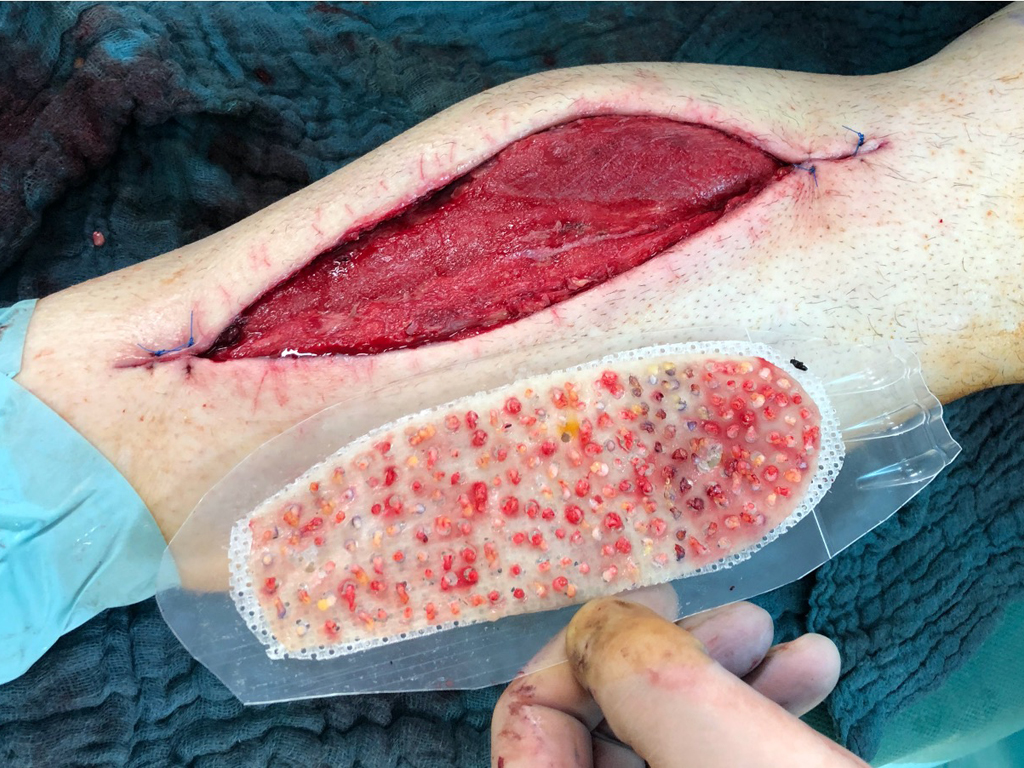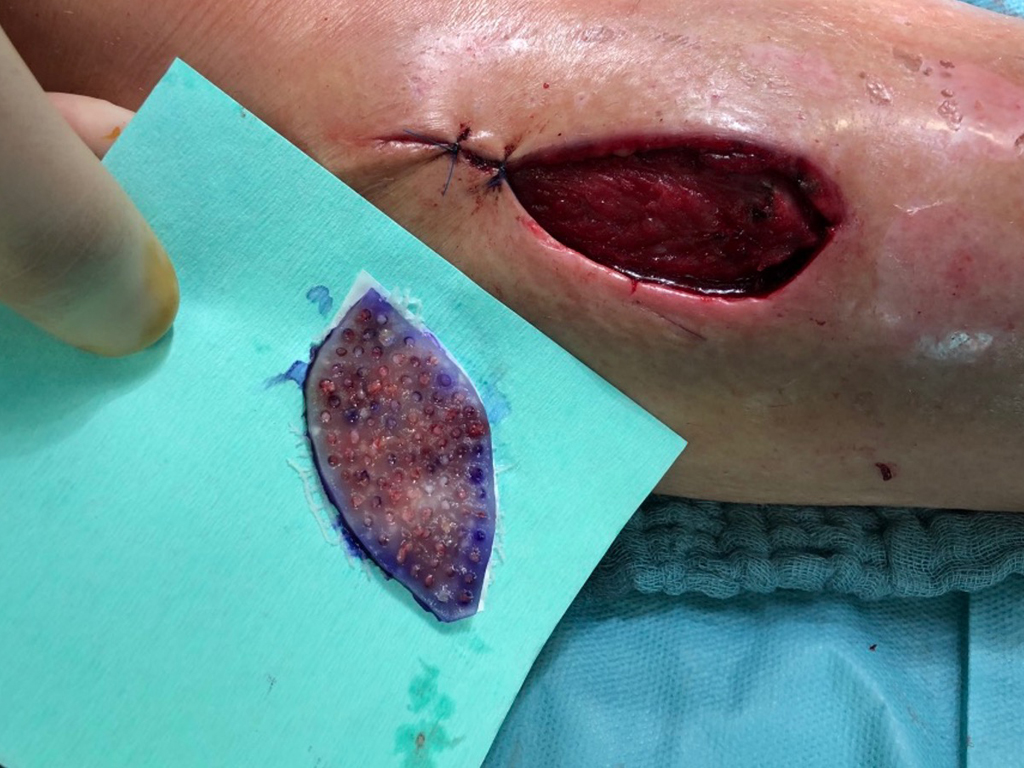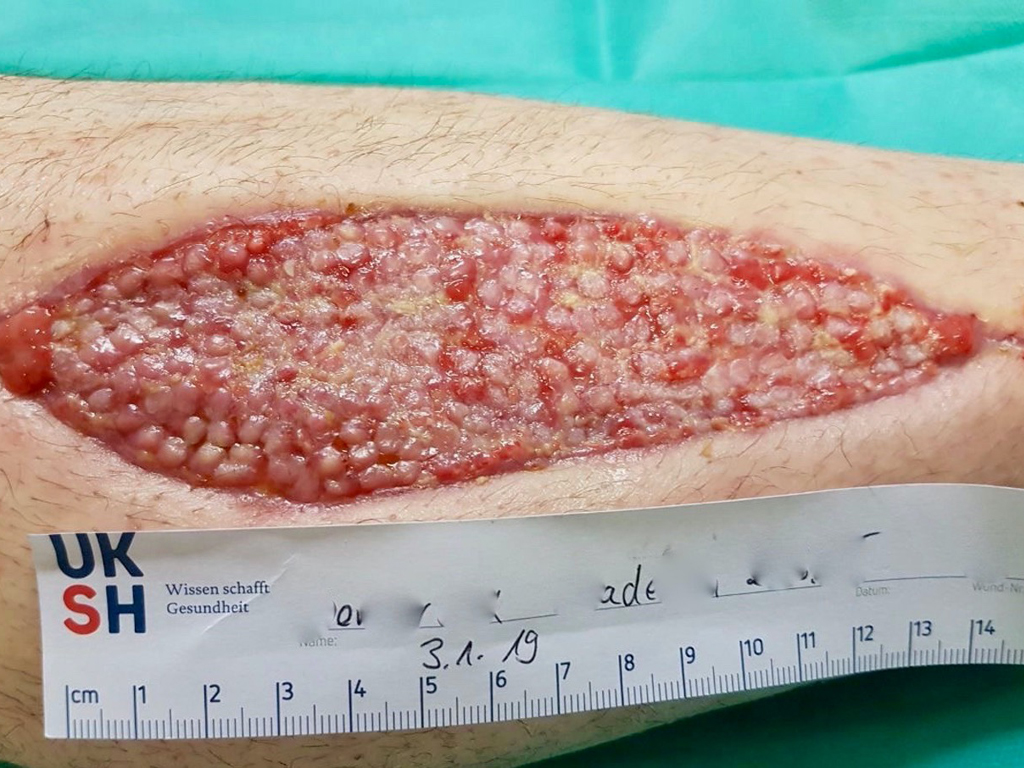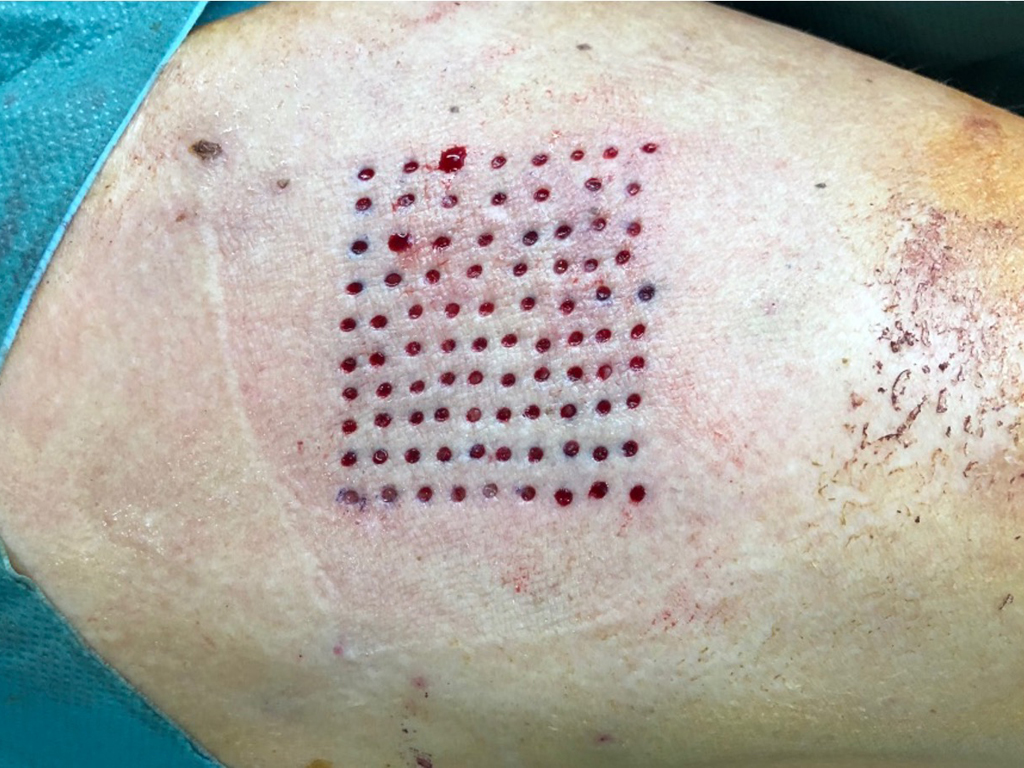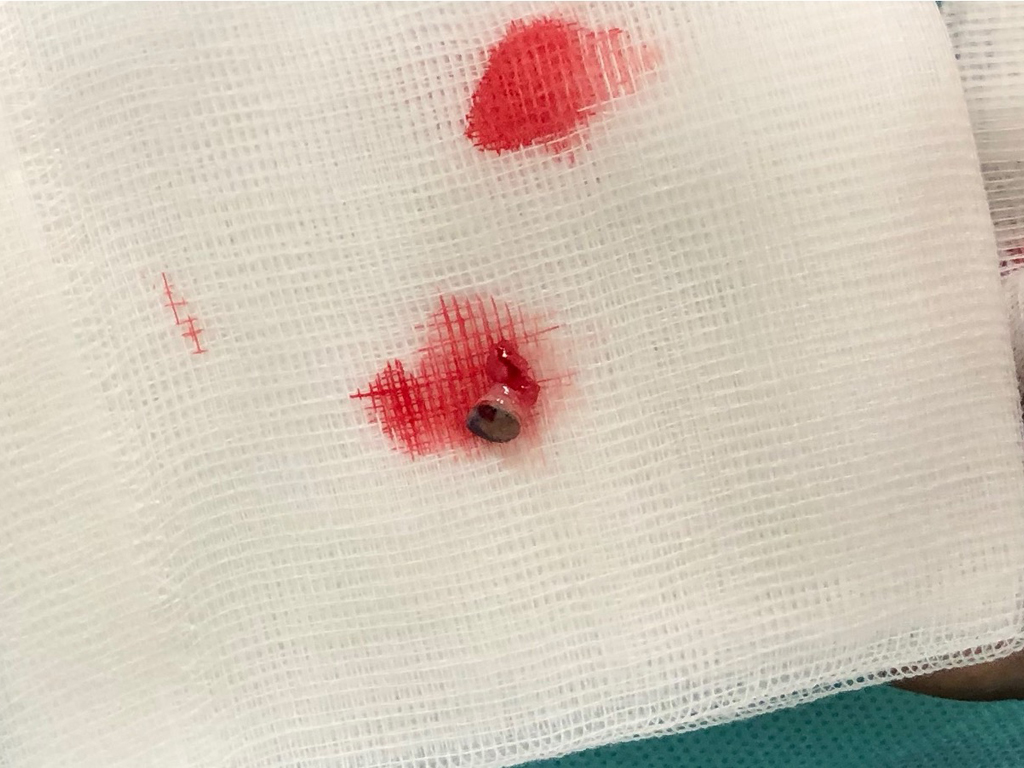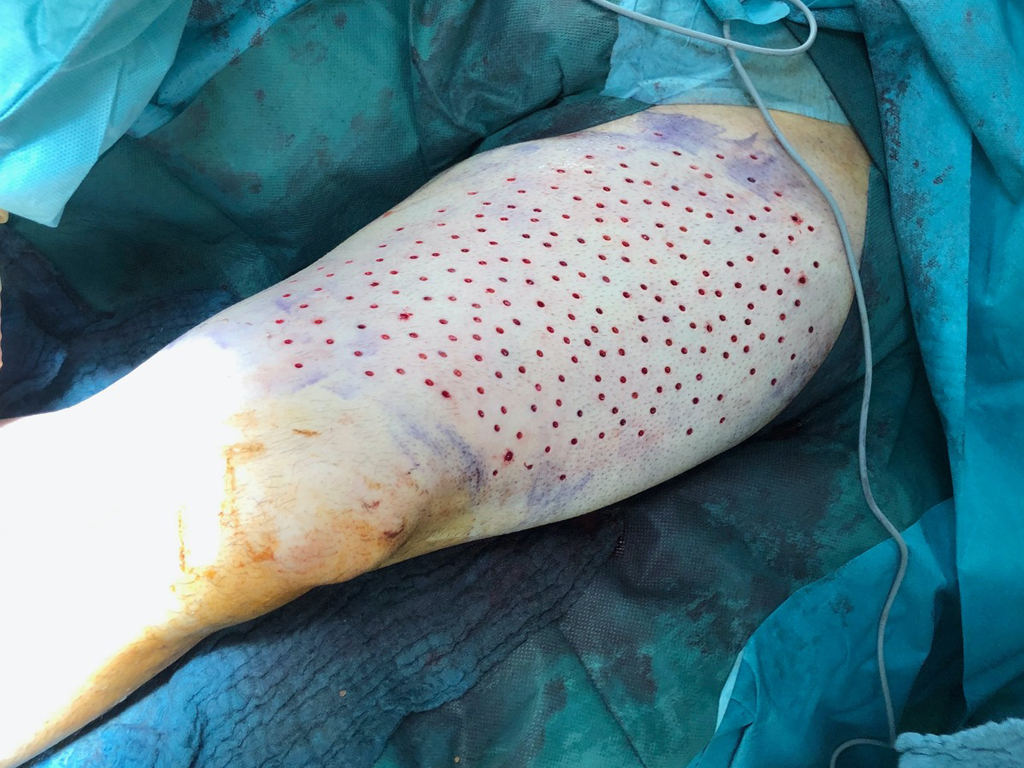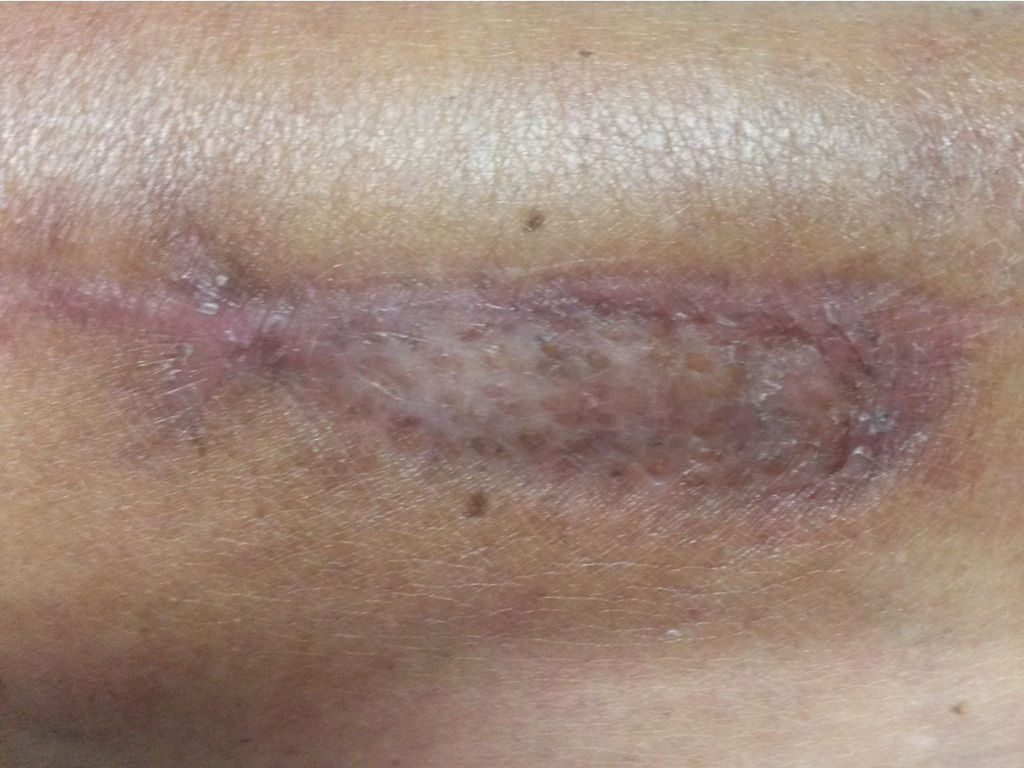Your Skin Transplant Experts
Which skin transplantation procedure for which indication? What are the advantages and disadvantages of the SkinDot surgical procedure compared to the previous full-thickness skin transplantation and to split-thickness skin? When are cultured skin procedures such as keratinocyte sheets or spray cell application indicated? For which patient is phlebotomy replacement suitable?
Ask our experts
Dermal replacement procedures
For deep wounds with complete loss of all skin layers, a collagen-based dermal substitute can be grafted into the wound. This collagen matrix acts as a skin shifting layer. A thin layer of skin must then be transplanted over the dermal substitute.
Culture skin method
Since the 1980s, skin cells can be grown in the laboratory. The skin cells grown (cultured) in the laboratory can be inserted into the wound as cell layers or sprayed on the wound.
Split skin graft
For extensive burns and very superficial wounds, so-called split-thickness skin grafting is the treatment of choice. Split skin consists of an ultra-thin skin graft of the thickness of only 0.2 mm.
SkinDot skin graft
In the case of a deep wound with a loss of the entire skin, skin replacement with so-called full-thickness skin provides the best result. Full-thickness skin grafts are very stable due to their dermal shifting layer and contain all skin appendages.
SkinDot Skin graft
The first reports of full-thickness skin grafts date from ancient India, about 2500 to 3000 years ago. The first reports of skin grafts in modern times date from the second half of the 19th century (1872 Ollier, and 1875 Wolf, respectively). Other luminaries such as Reverdin (1899) and Davis (1910) established full-thickness skin transplantation.
Anatomically, a full-thickness skin graft, as the name implies, consists of the full-thickness skin: epidermis and dermis. Therefore, it also contains the skin appendages, such as hair roots, sebaceous glands, appocrine and eccrine sweat glands. This must be taken into account when choosing the harvesting and recipient site. In particular, undesirable hair growth at the recipient site should be avoided.
A healed full-thickness skin graft can sweat just like healthy skin, and regular oiling is also not necessary, unlike split-thickness skin. Full-thickness skin is much thicker than split-thickness skin and therefore places much higher demands on the recipient bed than split-thickness skin. The wound bed must be well capillarized and supplied with blood. Compromises in this regard often lead to graft loss. Exposed bone or cartilage without perichondrium are not suitable, nor are exposed tendons. To create a well-vascularized wound area, basic anatomical structures rich in vessels, such as periosteum and perichondrium, must be preserved. Meticulous intraoperative hemostasis is eminently important. Hematoma compellingly lifts the full-thickness skin graft off the bed, prolonging the diffusion distance, which can lead to the demise of the full-thickness skin graft.
It should be borne in mind that hemostasis by electrocoagulation leaves behind necrotic tissue, which can trigger inflammatory reactions and promote infections. The biggest disadvantage of full-thickness skin transplantation has been the limited donor earel, so that only a maximum of 2-3% of the body surface could be covered with full-thickness skin. For larger areas, skin expanders can be used, but these often lead to foreign body reactions and are therefore very prone to complications. Continuous filling is also sometimes stressful for the patient.
With SkinDot, a full-thickness skin transplantation method is available for the first time that significantly reduces donor and recipient morbidity by harvesting millimeter-sized islands of skin. In addition, SkinDot makes it possible to achieve a full-thickness skin equivalent that is unprecedented in quality.
Healing of the full-thickness skin graft
Surgical results to date show a 100% take rate of transplanted 2 – 3 mm SkinDot full-thickness skin islands. To ensure shear forces and undisturbed recapillarization, we recommend applying a negative pressure dressing with a mild negative pressure of -75 mm HG for at least 10 days. Typical full-thickness skin grafting phenomena such as shedding of the epidermis have not been observed.
Indication for SkinDot Skin Graft
.
Die Indikation für ein Vollhauttransplantat besteht immer dann, wenn ein besonders stabiles Hauttransplantat erforderlich ist. Nur Vollhauttransplantate besitzen eine der gesunden Haut vergleichbare Qualität. Im Gegensatz zu dünnen Spalthauttransplantaten besitzen SkinDot Transplantate nur eine minimale Schrumpfungstendenz. Die Kontrakturtendenz von Spalthauttransplantaten führt zu den bekannten Narbenkontrakturen, die kosmetisch stigmatisierend und bewegungseinschränkend sein können.
Klassische Indikationen für Defektdeckungen durch SkinDot Vollhauttransplantate sind:
- Tiefe Defektwunden im Gesicht und Stirn (z.B. nach Basaliomentfernung IIb°-III° Verbrennungen)
- Tiefe Defektwunden an Händen und Füßen
- Vollhautverlust über Gelenkflächen
- Notwendiger Vollhautersatz am Amputationsstumpf (Belastungszone)
- Deckung von chronischen Wunden
- Narbenkorrekturen
- Trennung von Syndaktilien
Operative Procedure for SkinDot Skin Graft
.
In the new, innovative SkinDot procedure, the first step is to select a suitable donor area from which to harvest 1 – 3 mm skin islets. The donor area should be as identical as possible in skin texture to the wound to be transplanted. For example, if a full-thickness skin graft is needed in the right palm, the left palm is selected as the donor area. Only in the opposite hand will the skin have a comparable consistency, thickness and quality as in the affected hand. In case of a deep defect wound on the cheek, 1 mm skin is taken from the other side of the cheek. On the thigh or lower leg, on the opposite side in each case.
The SkinDot procedure results in a so-called full skin equivalent. After removal of the SkinDot full-thickness skin islands, the surgeon inserts them into a collagen matrix. The SkinDot islands are spaced 1 – 2 mm apart in the collagen matrix so that all skin layers are confluent. After the islands have been implemented into the collagen matrix, the matrix is transplanted into the wound.
To ensure safe healing, a negative pressure dressing is applied over the graft. This negative pressure dressing remains on the transplanted wound for approximately 10 days to protect the full-thickness skin islands from shear forces and to ensure undisturbed sprouting of the capillaries.
Recipient and donor area
.
Gesicht:
Da die entnommenen SkinDot Vollhautinseln den Hautverlust in der Defektwunde nahezu identisch ersetzen sollen, werden die Hauptinseln im unmittelbar angrenzenden Gesichtsbereich entnommen. Entnahme der Hautinseln bei einer Wunde an der Stirn daher an der Stirn, bei Hautverlust an der Wange an der gegenüberliegenden Wange usw. Die transplantierten Hautinseln im Gesicht haben eine Größe von maximal 1 mm, damit das Spenderareal unauffällig und kaum sichtbar beliebt. An der Abnahmestelle kann es mitunter zu Pigmentverschiebungen kommen, d.h. es können helle oder dunkle 1 mm große Punkte persistieren.
Décolleté:
Bei einer SkinDot Transplantation im Décolleté Bereich werden die Inseln am Décolleté entnommen. Das Prinzip der SkinDot Hauttransplantation besteht darin, dass die Inseln unmittelbar in der Nachbarschaft der Wunde entnommen werden, da nur dort die Haut das gleiche Aussehen und die gleiche Qualität wie in dem Wunddefekt besitzt.
Gelenkflächen:
Über Gelenkflächen ist ein stabiles und belastbares Vollhauttransplantat erforderlich. Nur Vollhauttransplantate besitzen keine Kontrakturneigung. Durch diese Schrumpfung resultieren bei alternativen Transplantationsverfahren oftmals Funktionseinschränkungen. Die Kontrakturtendenz dünner Hauttransplantate zeigt sich besonders im Halsbereich, so dass stereomentalen Kontrakturen resultieren können.
Hände und Füße:
Die Haut des menschlichen Körpers hat an den Handflächen und Fußsohlen ihre maximale Belastbar- und Zugfestigkeit. Diese äußert sich bei wiederholter Belastung durch sogenannte Schwielen. Losses of the skin mantle in these areas often lead to massive restrictions in everyday life when replaced by thin skin grafts (split skin). Thin skin grafts are very vulnerable and susceptible to infection. Removing the SkinDot full-thickness skin islets from the opposite hand or foot results in a stable and resilient full-thickness skin graft that is comparable to the original skin.
Skin loss on the trunk of the body:
Again, the transplanted skin should be of comparable consistency, thickness and quality. The number of skin appendages varies greatly depending on the location. The skin has a completely different thickness in the neck than in the shin, for example. With the SkinDot procedure, if skin is lost in the neck, the defect is replaced only with skin islands that were also taken from the neck. In the case of full-thickness skin wounds on the tibia, depending on the size of the wound, the islands are taken only from the affected tibia and/or the opposite tibia. Only the surgical SkinDot procedure therefore guarantees a comparable skin replacement in the recipient area.
Operating result
The results after SkinDot skin grafting vary greatly between individuals and depend on wound location, pre-existing conditions, skin type and color, and patient age. Wound healing is a complex, multifactorial physiologic process that occurs differently in each individual. The cosmetic and functional results to date after SkinDot transplantation are very promising. Minimal scarring and a stable and resilient skin graft result. However, it would be unscientific and unfair to promise a skin substitute that is 100% like healthy skin. Compared to previous skin grafting procedures, however, the SkinDot procedure is characterized by the fact that it comes very close to healthy skin and is superior to previous skin grafting procedures.
Do you want to offer the new, innovative SkinDot procedure to your patients? Contact us! We support you with joint surgery planning, surgery execution, matrices, and corresponding patient documents (informed consent form, risk exclusion). We look forward to hearing from you!
Skin Transplantation beyond
Skin Transplantation 2.0

